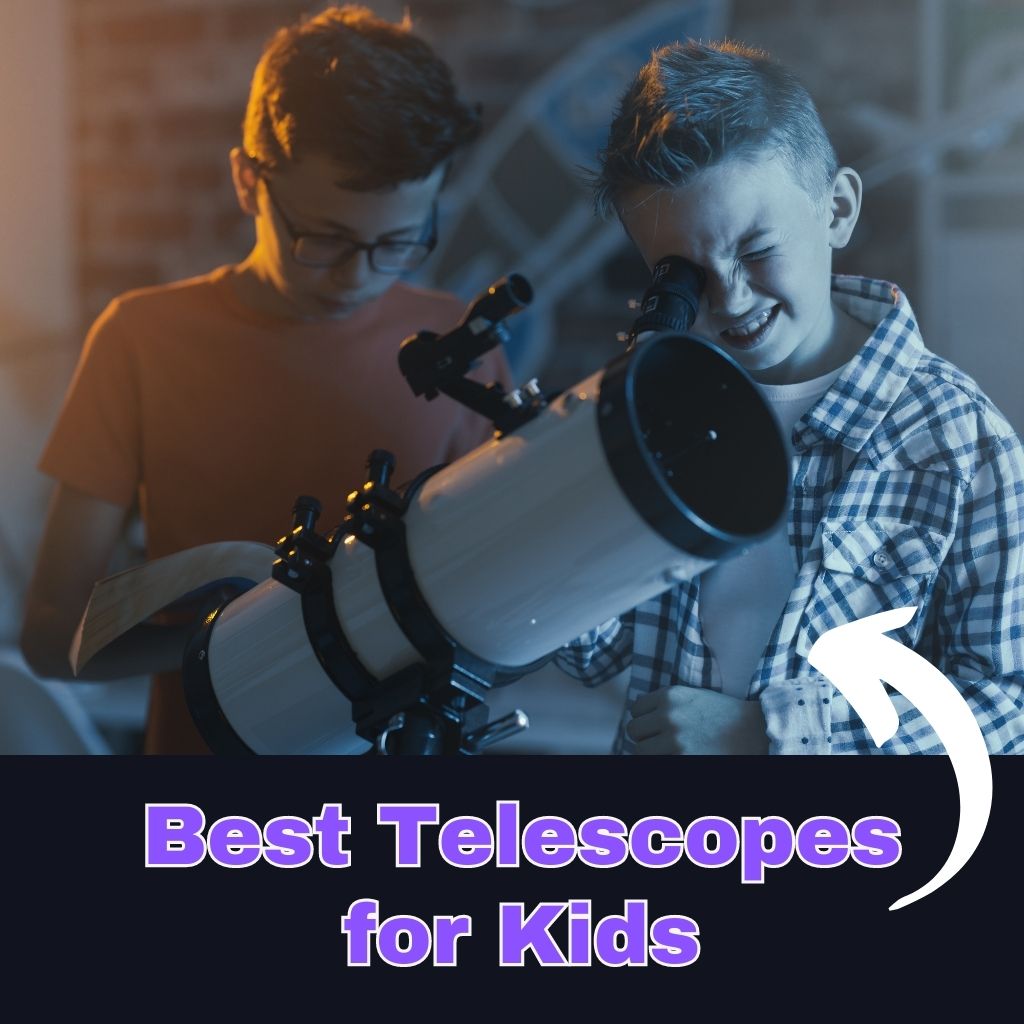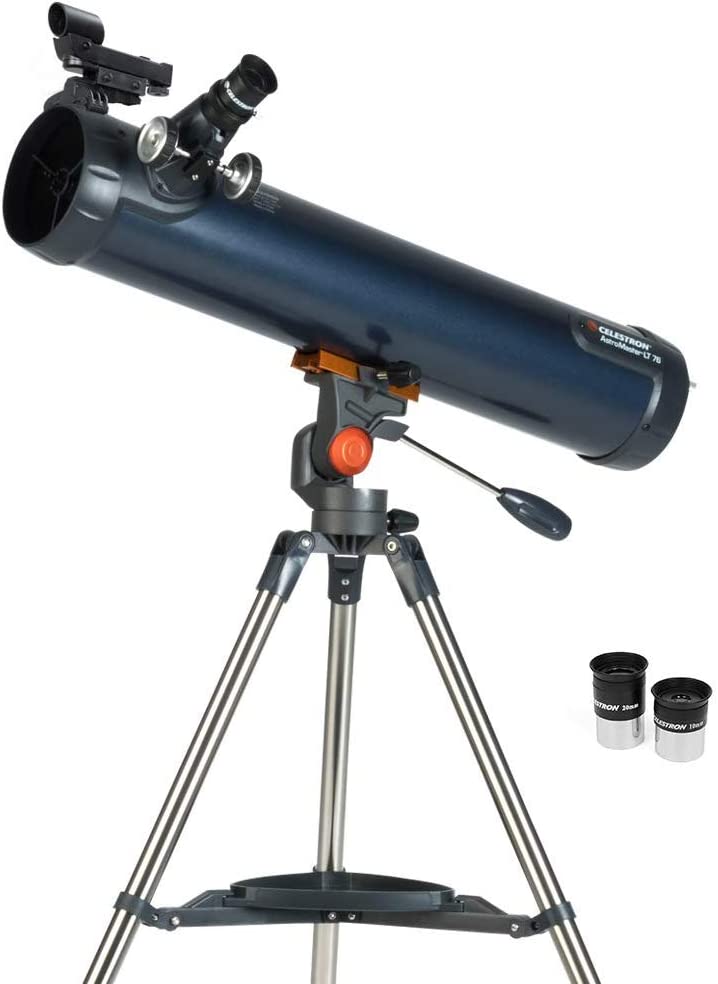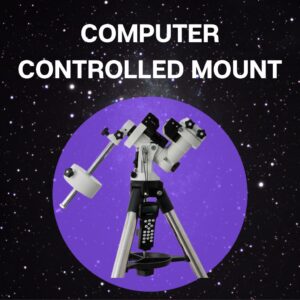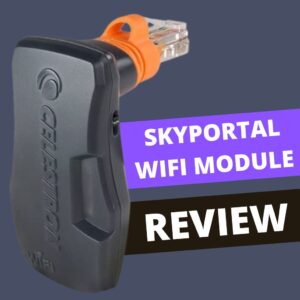This site contains affiliate links to products. I may receive a commission for purchases made through these links.
When selecting the ideal telescope for children in 2023, there are several considerations to keep in mind to ensure a rewarding and educational stargazing experience:
- The ease of use
- The durability and safety
- The child’s age and astronomical interest level
- The type of telescope and its specific features like magnification power, stability, and portability.
- The educational value.
This guide will explore various options, ensuring you find a telescope that not only excites but also educates.
Best telescopes for toddlers (kids under 5 years old)
For younger children, a toy telescope can be an excellent introduction to astronomy. Some of the best options available include:
1. GeoSafari Jr. Talking Telescope
GeoSafari Jr. Talking Telescope helps kids learn fun facts about space without going outdoors! This scientific “toy” telescope can help you teach them something new and exciting and spend many unforgettable times under the stars.
Listen closely as it shares 120 cool facts about space, plus a fun quiz show with 120 questions for the ultimate science show-and-tell experience.
It includes 24 eye-opening images straight from the cosmos, and it is one of the best telescopes for toddlers. It promotes STEM learning and encourages an appreciation of exploration and discovery.
2. Educational Insights GeoSafari Jr. My First Kids Telescope
This toy is a perfect starting point if you have kids around 4 years old. It is an elementary scope with 9x magnification, so it is not a high power but perfect for kids. It is also a focus-free scope.
The most important feature is that it has two large eyepieces with quite a large field of view. This is good because, for kids at that age, it’s hard to observe something with one eye closed, while with two eyes open, it is more natural for them.
Another useful feature is that they can observe objects on earth during the day, like birds, trees, etc., because the image is not upside down like in a proper telescope.
The build is sturdy with a small, easy-to-operate tripod. They will be amazed to see the moon even with this toy.
Best telescopes for elementary students (5-10-year old kids)
What is the best telescope for a 10-year-old kid? This is a question many parents planning to buy one ask. Unlike the previous category, you have many more options for kids aged 5-10 years. Here is a list of the best telescopes for elementary students:
3. Emarth Telescope, Travel Scope, 70mm Astronomical Refractor Telescope
This small refractor is a fantastic choice for kids aged 5-10 years old, and it’s the kind of telescope many adults wished they had as children. It requires very little maintenance, with occasional cleaning of the lens being the only real task.
The telescope has a lens diameter of 70mm and a focal length of 360mm, providing an excellent gateway into astronomy.
Inside the box, you’ll find two eyepieces offering 14x and 36x magnification, which can be increased by 3x with the included Barlow lens.
However, it’s important to note that magnification isn’t the most crucial factor when choosing a telescope. The scope’s aperture (diameter) determines how much light it can collect.
With a 70mm diameter, this telescope is more than sufficient for beginners, providing crystal-clear images of the moon and planets.
The telescope also comes with a small finderscope with a lower magnification to help locate and point the telescope at objects in the sky. It’s easy to align with the main telescope, and instructions are included.
Additionally, a detailed moon map is included in the package, which is an excellent bonus for kids to learn the names of craters and areas on the moon. This is why it is the best telescope for elementary students.
If you’re worried about seeing images upside down through the telescope, don’t be. That’s how telescopes work. If you want to use it during the day to observe terrestrial objects, an Erecting Image Diagonal is included in the box.
4. Celestron Inspire 100AZ refractor
The Celestron Inspire 100AZ is also designed with user-friendly features that make it easy for kids to use. For example, the altazimuth mount allows for smooth and intuitive movement, while the red dot finder makes locating celestial objects in the sky easy.
The included software, Celestron’s Starry Night Basic Edition, is an excellent tool for beginners and can help kids learn about the night sky, plan observing sessions, and identify celestial objects.
The Celestron Inspire 100AZ is an excellent choice for parents who want a child telescope to get their kids interested in astronomy without spending a fortune.
It’s easy to set up, use, and transport and comes with everything a beginner needs to observe and explore the night sky.
5. Solomark Telescope for Kids
The SOLOMARK telescope is a gift that keeps on giving. From stargazing to animal watching, this telescope has various accessories to enhance your child’s experience.
With two eyepieces of varying magnifications, a Barlow lens, a smartphone adapter, a sunshade, a backpack, and a tripod, your child will have everything they need for their adventures.
If your child wants to capture their experience, they can easily attach their phone to the smartphone mount and take stunning pictures.
This telescope is versatile yet straightforward, with no need to feel intimidated by the many accessories. Just grab the telescope out of the box and start exploring the wonders of the universe.
Best telescopes for children (between 10 to 15-year-old)
This is the age when you can determine whether your kid has a genuine interest in astronomy and telescopes. If they are interested, consider investing more in their hobby.
When it comes to telescopes, you get what you pay for, and telescopes for 10-15-year-old kids are no exception. If you already own a telescope suitable for children aged 5-10, now may be a good time to upgrade to a more advanced telescope like the Celestron 31036 AstroMaster LT 76AZ and the Orion SpaceProbe II 76.
6. Celestron 31036 AstroMaster LT 76AZ
The Celestron 31036 AstroMaster LT 76AZ is an advanced telescope that will give your kids a more detailed and explicit image, enabling them to see and learn more about the universe.
The Celestron 31036 AstroMaster LT 76AZ is a mirror-based reflector, and as we know, reflectors are less expensive than refractors with lenses. However, this telescope costs a bit more, but it is worth the investment.
This Astromaster is a lightweight, portable, and easy-to-assemble telescope. Its altazimuth mount is easy to operate, with a small panhandle to point the telescope in the right direction.
This telescope is not just limited to viewing the moon and planets. It can also provide a clear image of brighter nebulas and star clusters.
Celestron is a well-respected brand in the world of telescopes, and you can’t go wrong with purchasing their products.
7. Orion SpaceProbe II 76
The Orion SpaceProbe II Newtonian is another excellent option for parents looking for a high-quality telescope for their kids without breaking the bank.
This telescope is built on Newtonian optical-path design and comes with two eyepieces that provide magnifications of 28x and 70x, making it perfect for viewing big and bright sky objects.
The Altazimuth reflector is easy to move under the night sky and doesn’t require any tools to set up.
In addition to the eyepieces, the telescope comes with a star finder and a finderscope to help kids locate objects in the sky. The telescope can be easily adjusted in any direction and locked in place with a simple knob.
Best telescopes for teenagers (15+ year-old)
For teenagers aged 15 years and older, we recommend two excellent options.
- The Celestron NexStar 130SLT Computerized Telescope
- Orion 8944 SkyQuest XT6 Classic Dobsonian Telescope
They are good telescopes for teenagers. They will provide many years of observing the sky and make your kids happy, no matter your choice.
They both offer advanced features such as computerized tracking and large apertures, allowing for detailed views of deep-sky objects such as galaxies and nebulae. The main differences between them are size and mount.
Let’s discuss their features in detail:
8. Celestron NexStar 130SLT Computerized Telescope
The Celestron NexStar 130SLT Computerized Telescope is a 130/650 reflecting telescope with a motorized mount. This feature solves the problem of objects moving out of the frame within a few seconds.
The GoTo system, with thousands of objects in the database, allows for easy finding and keeping of objects in the scope.
The scope is easy to align, and the sturdy and height-adjustable tripod comes with a power adapter or can be used with batteries when outdoors.
The aperture is big enough to collect lots of light and provide breathtaking images of almost any object in the night sky.
It’s a perfect telescope for kids with a passion for astronomy, and it’s highly recommended even for older teenagers and young adults.
9. Orion 8944 SkyQuest XT6 Classic Dobsonian Telescope
The Orion 8944 SkyQuest XT6 Classic Dobsonian Telescope is a big telescope with an affordable price. It’s very mobile because of the Dobsonian mount, which is a solid base on the ground with a mounted telescope.
This mount can handle bigger and heavier scopes, and Dobsonian telescopes are more affordable than tripods.
This telescope provides crystal-clear images with great detail and is popular among beginners and amateur astronomers.
Kids will enjoy feeling like they’re in orbit above the moon and seeing the craters up close. They can also explore other galaxies and nebulas with this fantastic instrument.
Professional telescopes for 18-year-old
A professional telescope that offers advanced features, such as computerized tracking and high-quality optics, is excellent for older children. Some of the best options available include
10. Celestron NexStar 8 SE Telescope
If you have an astronomy enthusiast at home who is turning 18 and interested in video astronomy, Celestron NexStar 8 SE Telescope would be an excellent gift.
Celestron NexStar 8 SE Telescope is a professional-grade Maksutov-type telescope, which is famous and a favorite among amateur astronomers.
The telescope comes with a GoTo motorized mount and high-end optics and can be moved easily.
Although it may seem small, the Maksutov design allows for a physically smaller tube with a much longer focal length. This is because it combines a spherical mirror with a weakly negative meniscus lens.
It’s a future-proof instrument that can stay in your family forever.
While all telescopes mentioned earlier are sufficient for children and teenagers interested in stargazing, this one is a bonus recommendation if you can spare the money.
Read also: Maksutov Newtonian Telescopes (In-depth Guide)
11. Orion StarBlast II 4.5 Equatorial Reflector Telescope
The Orion StarBlast II Telescope is an excellent choice for those who want to view deep space objects with clarity. With its compact size, it can be easily transported won’t take up much space, and can be stored away easily.
Its reflecting optics provide great views of planets, the moon, galaxies, and star clusters, making it perfect for teenagers who want to explore the cosmos.
The EQ-1 mount and slow motion controls enhance object tracking and make it easy to focus on moving objects. However, some people have found the assembly process a bit tricky.
Once it’s set up, users can take advantage of the 10mm and 25mm eyepieces to see far into space.
The tripod is also adjustable to suit the height of teenagers. The Orion StarBlast II Telescope is a great choice for anyone looking for an easy-to-use, portable telescope with excellent optics. You should consider this telescope if you are looking for the best astronomy telescope for your 18-year-old.
Factors to consider when shopping for a kid’s telescope
If you are planning to buy a telescope for your kids, consider the following:
Kid’s age
Your child’s age is one of the most important factors to consider when buying a telescope. We do not recommend buying a telescope for a toddler because a child can’t comprehend images in the eyepiece until they reach a certain age, usually around five.
However, suppose you want to spark astronomy interest in your child earlier than that. In that case, we will give you some tips later in the article because there are pretty cool toy telescopes available that can spark astronomy interest in your kids.
Children’s interests in astronomy
Consider your child’s interests and what they hope to achieve with the telescope. Do they want to explore the moon and planets, or are they more interested in deep-sky objects like galaxies and nebulae?
Understanding their interests will help you choose the best kids’ telescope to keep them engaged and excited about astronomy.
Budget
When buying a telescope for a child who is genuinely interested in astronomy, it’s essential to consider your budget. Spending only a little money on the first telescope to distinguish between a passing interest and a long-term hobby is a good practice.
The reason is that some children may not take to astronomy as expected. A budget-friendly model is advisable. However, a better-quality telescope will keep your kids engaged and interested for extended periods.
That said, typically, telescope prices start as low as $20 for toys to professional scopes over $4000 in different shapes and setups. Depending on your child’s age, including teenagers, we recommend setting a budget between $50 to $350, with the older child’s scope being on the higher end.
Note that the type of telescope you want can impact your budget. There are two major types:
- Refractor telescopes (uses only lenses in its optical tube)
- The Reflectors (use mirrors).
The rule of thumb is that mirror telescopes are cheaper than telescopes with lenses, but we will recommend a refractor if it is for a younger kid because it needs almost no maintenance. On the other hand, Reflectors must have their mirrors aligned occasionally, so this can be a problem for younger kids.
However, if you also want to be involved in using the telescope, feel free to buy a reflector, as aligning the mirrors should be easy for you.
You may also like: Reflector vs. Refractor Telescope: Which One Do You Need?
Features of the kid’s telescope
There are many features and functionalities of a telescope you need to consider. But let’s focus on the three things you need to know about a telescope.
Aperture of the telescope
Aperture refers to the diameter of a telescope’s light-gathering mechanism (a lens or a mirror). The bigger the aperture size of the telescope, the more light it can capture, allowing for more distant viewing.
Focal length of the telescope
The focal length is the distance in millimeters between the telescope’s mirror or lens and the optical tube’s focal point (the point at which the telescope is in focus). A longer focal length generates a larger image.
Magnification of the telescope
The magnification of a telescope is its focal length divided by the eyepiece focal length in millimeters. A telescope with a higher magnification number delivers a larger image.
Additionally, magnification is the least among the list of measurements to consider. Instead of focusing on magnification, look for telescopes with large apertures and long focal lengths, as these are the most critical measurements for a child’s first telescope.
If you’re interested in exploring more expensive options or are searching for a telescope that the entire family can enjoy, check out this article, 9 Best Telescopes Under $1000 (Read This first!).
Reason for buying the telescope for your child
Before buying a telescope, it is essential you know why you are making the purchase. The type of telescope and the qualities and services offered by the telescope you purchase will depend directly on your needs and requirements.
However, since you plan to get the telescope for a youngster, you don’t need a professional one except if you plan to purchase one for your older kids.
Safety first!
When you eventually buy a telescope for your kids, never let them use the telescope during the day without supervision. It’s essential to explain to them the danger of looking at the sun through the telescope.
This rule, of course, applies to all telescope users. It is a crucial safety measure with telescopes. Observing the sun without proper protection can cause severe and permanent eye damage.
That said, observing the sun is a breathtaking experience, but you can do it only with a solar filter attached to the telescope.
We recommend the Celestron – EclipSmart Safe Solar Eclipse Telescope Filter for solar filters. With this solar filter attached, your telescope becomes a solar scope!
FAQs about children’s telescope
Let’s delve into some additional frequently asked questions about children’s telescope.
Is it worth investing in a telescope for children?
Investing in a telescope for children can be incredibly worthwhile, as it opens the door to a fascinating and educational experience. A telescope not only introduces children to the wonders of astronomy and science but also encourages curiosity, patience, and a greater appreciation for the natural world. The hands-on experience of exploring the night sky can ignite a lifelong passion for learning and discovery. Moreover, observing celestial bodies can be a bonding activity for families, fostering a shared interest and time spent together.
What is the best telescope for kids?
Some of the best telescopes for 5-year-old kids and older include:
- Educational Insights GeoSafari Jr.
- GeoSafari Jr. Talking Telescope
- Celestron 31036 AstroMaster LT 76AZ Telescope
- Emarth Refractor Telescope
But there are general factors to consider when getting a telescope for your kids. The best telescope for kids must be durable, offer a good viewing experience, and be lightweight and compact for easy transport and storage. It should also have a sturdy tripod and adjustable height for easy use.
For older kids, please look at the recommended telescope in the sections above for kids 15 years and above.
What is the best starter telescope for 9-year-old kids?
Some of the best starter telescopes for 9-year-old kids include
What is the best telescope for a 10-year-old?
The best telescope for a 10-year-old include
What is the best tabletop telescope for a kid?
A tabletop telescope is designed to be placed on a flat surface, such as a table or a desk, and there are many suitable types for kids in the market.
Here are four tabletop telescopes for kids we recommend:
- Celestron FirstScope 76 Tabletop telescope
- Celestron 21024 FirstScope Telescope
- Skywatcher Heritage 130 Tabletop Dobsonian
Tabletop telescopes are also often less expensive than larger telescopes, making them a popular choice for beginners or those on a budget.
Do you need a tripod to use a telescope for kids?
To capture high image quality when looking through a telescope, you need a tripod to help keep the telescope stable and make it easier to adjust its position. However, if you have a tabletop telescope, a tripod is not required.
What is the best family telescope?
The best family telescope depends on the needs and preferences of your family. If you are looking for a telescope that is easy to use, portable, and can be enjoyed by everyone, we recommend these popular telescopes:
Additionally, remember to consider the type of objects you want to observe and your budget when choosing a family telescope.
You may also like: 21 Best Telescopes for Beginners (Ranked!)
What can you see through a children’s telescope?
The capabilities of a children’s telescope, largely determined by its type and aperture size, vary in terms of the clarity and range of celestial objects they can reveal. Telescopes with a smaller aperture, around 60 mm to 70 mm, can display larger lunar craters, major planets, and Saturn’s rings, albeit with limited clarity.
Upgrading to a telescope with an aperture between 90 mm and 130 mm enhances the viewing experience, allowing for the observation of finer lunar details, Mars’ polar caps, Jupiter’s moon shadows, and even distant planets like Uranus and Neptune, though they appear as small, bright discs.
Takeaway: Getting the best telescopes for your kids can spark their interest in astronomy
No matter how old your kid is, buying a telescope is a good idea because you never know; maybe you have a future famous astronomer at home waiting for their first telescope.
Besides, buying the telescope will help introduce them to science, and they will learn a rewarding hobby.
That said, it can be overwhelming to choose the best telescope for children, so in this piece, we have made your research work a bit easier by recommending some of the best telescopes for your kids, taking into consideration their age, interest, budget, features, the reason for buying, and safety.
No matter which one you select, you will never be disappointed. Hence, you can rest assured that the telescope shared in this list will provide your child with an unforgettable stargazing experience.
You may also like:
















